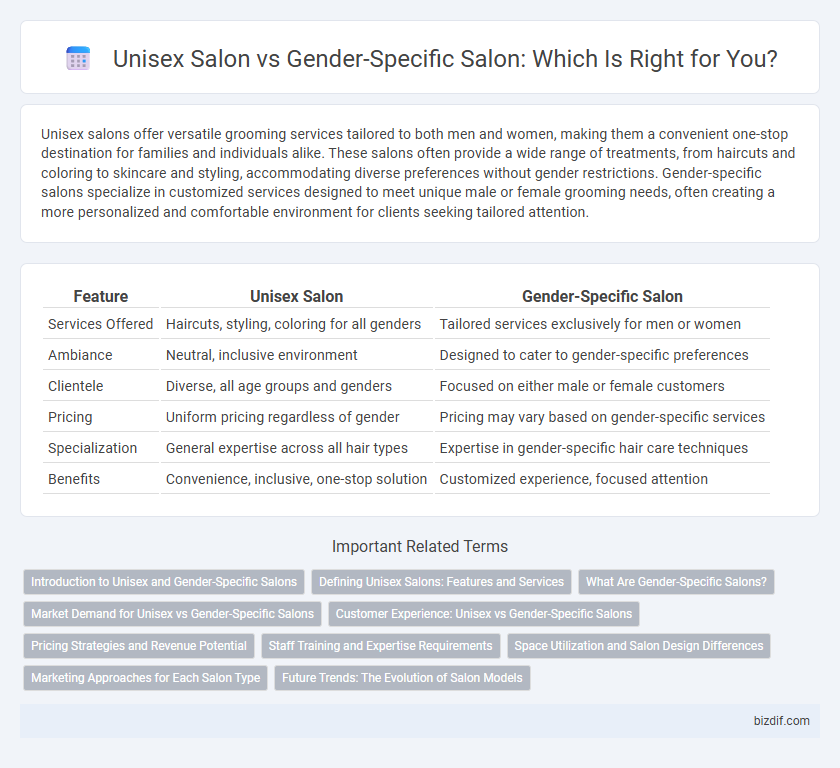Unisex salons offer versatile grooming services tailored to both men and women, making them a convenient one-stop destination for families and individuals alike. These salons often provide a wide range of treatments, from haircuts and coloring to skincare and styling, accommodating diverse preferences without gender restrictions. Gender-specific salons specialize in customized services designed to meet unique male or female grooming needs, often creating a more personalized and comfortable environment for clients seeking tailored attention.
Table of Comparison
| Feature | Unisex Salon | Gender-Specific Salon |
|---|---|---|
| Services Offered | Haircuts, styling, coloring for all genders | Tailored services exclusively for men or women |
| Ambiance | Neutral, inclusive environment | Designed to cater to gender-specific preferences |
| Clientele | Diverse, all age groups and genders | Focused on either male or female customers |
| Pricing | Uniform pricing regardless of gender | Pricing may vary based on gender-specific services |
| Specialization | General expertise across all hair types | Expertise in gender-specific hair care techniques |
| Benefits | Convenience, inclusive, one-stop solution | Customized experience, focused attention |
Introduction to Unisex and Gender-Specific Salons
Unisex salons cater to all genders, offering versatile haircuts, styling, and grooming services that promote inclusivity and convenience within a single location. Gender-specific salons specialize in tailored treatments, focusing on the unique hair care and styling needs of men or women, often providing a more personalized atmosphere. Understanding the distinctions between unisex and gender-specific salons helps clients choose a salon environment that best suits their preferences and service expectations.
Defining Unisex Salons: Features and Services
Unisex salons offer inclusive services for all genders, providing haircuts, styling, coloring, and grooming in a single space tailored to diverse client needs. These salons emphasize versatility and convenience by employing stylists skilled in a broad range of techniques suitable for men, women, and non-binary individuals. Modern unisex salons often feature contemporary decor and use advanced products designed to accommodate various hair types and styles, enhancing customer experience through personalized care.
What Are Gender-Specific Salons?
Gender-specific salons cater exclusively to either men or women, offering specialized services tailored to the unique hair and beauty needs of each gender. These salons often focus on traditional gender-based grooming styles, such as barbering techniques for men or advanced hair treatments and styling for women. By targeting a specific demographic, gender-specific salons create an environment designed to meet the particular preferences and expectations of their clientele.
Market Demand for Unisex vs Gender-Specific Salons
Market demand for unisex salons has surged due to growing consumer preference for inclusive and versatile grooming options that cater to all genders under one roof. Gender-specific salons maintain strong appeal within niche markets valuing specialized services tailored exclusively to men's or women's beauty needs. Industry reports indicate unisex salons dominate urban areas with diverse demographics, while gender-specific salons retain loyalty in communities prioritizing tradition and targeted expertise.
Customer Experience: Unisex vs Gender-Specific Salons
Unisex salons offer a streamlined customer experience by providing diverse services for all genders in a single location, promoting convenience and inclusivity. Gender-specific salons often excel in personalized treatments tailored to distinct hair and skincare needs, enhancing comfort and satisfaction for their targeted clientele. Choosing between unisex and gender-specific salons depends on the importance of individualized care versus the preference for a versatile, all-in-one environment.
Pricing Strategies and Revenue Potential
Unisex salons typically adopt competitive pricing strategies to attract a broader customer base, leveraging services that appeal to all genders and thereby maximizing revenue potential through higher client volume. In contrast, gender-specific salons can implement premium pricing, targeting niche markets with specialized treatments and customized experiences that justify higher rates and foster customer loyalty. Both models balance pricing and service offerings to optimize profitability, with unisex salons favoring scale and gender-specific salons emphasizing specialization.
Staff Training and Expertise Requirements
Unisex salons demand comprehensive staff training encompassing a broad range of hairstyling, skincare, and grooming techniques suitable for all genders, ensuring versatility and inclusivity in service delivery. Gender-specific salons require specialized expertise tailored to distinct male or female grooming needs, emphasizing targeted skills in haircutting, coloring, and treatment protocols unique to each gender. Both salon types necessitate ongoing professional development to stay updated with evolving trends and customer preferences, but unisex salons often invest more in cross-disciplinary training to accommodate diverse clientele.
Space Utilization and Salon Design Differences
Unisex salons maximize space efficiency by integrating versatile design elements that accommodate diverse services and clientele within a unified area. Gender-specific salons often allocate separate zones tailored to gender preferences, resulting in distinct decor and spatial divisions that may limit overall capacity. Flexible layouts in unisex salons enhance operational flow and optimize resource use, contrasting with the customized, segmented design approach typical of gender-specific establishments.
Marketing Approaches for Each Salon Type
Unisex salons leverage inclusive marketing strategies emphasizing versatility and convenience to attract a diverse customer base seeking a one-stop grooming destination. Gender-specific salons target niche segments using tailored messaging that highlights specialized services catering to the unique aesthetic preferences and needs of men or women. Digital campaigns for unisex salons prioritize broad appeal through social media and online reviews, while gender-specific salons often utilize influencer partnerships and community events to build brand loyalty within their demographic.
Future Trends: The Evolution of Salon Models
The future of salon models indicates a significant shift towards unisex salons as they cater to a broader clientele and emphasize inclusivity, reflecting evolving societal norms around gender. Technological advancements and personalized service options in unisex salons enhance customer experience by addressing diverse hair care needs across gender identities. Market analysis reveals that unisex salons are poised for growth, driven by increasing demand for flexible and universal beauty services that transcend traditional gender-specific boundaries.
Unisex Salon vs Gender-Specific Salon Infographic

 bizdif.com
bizdif.com